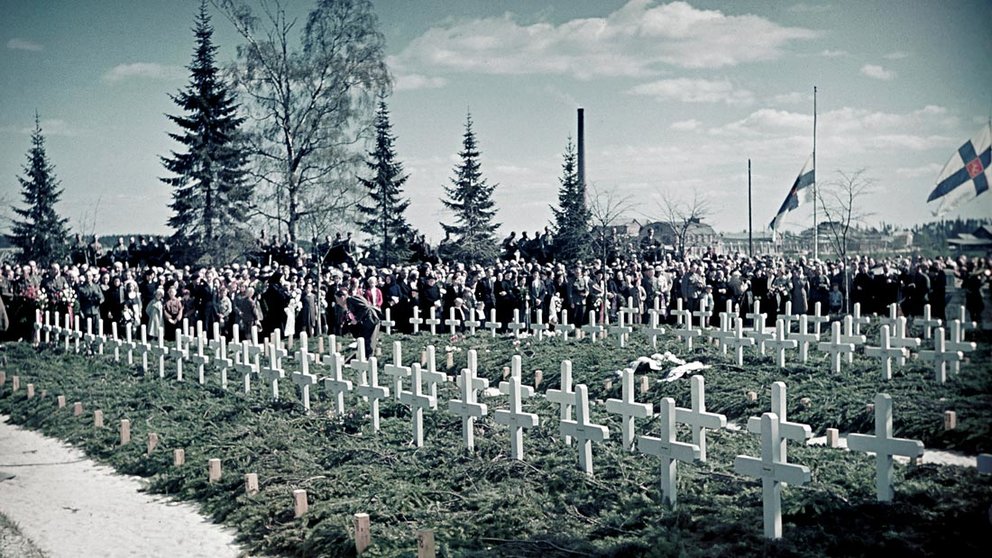March 13, 1940.
Gunshots could no longer be heard on the Soviet-Finnish frontier. The peace agreement had come into effect. The war was officially over.
Yet, it was one of the saddest days in the history of independent Finland.
The Finnish delegation could not hold back tears when they signed the Moscow Peace Treaty. Now, Finns were in tears as they walked on the streets in their beloved country.
Those returning from the battlefield considered themselves part of an unbeaten army but still shed tears after they came to know the harsh peace terms.
The entire nation was in deep mourning.
450,000 Finns become homeless
Finland paid dearly in the war.
Compared to the opponents, Finns suffered fewer casualties but it was still a substantial loss for a nation of some four million people at that time. The war cost the lives of 25,000 Finns while 55,000 were wounded.
The Soviet Union, as part of the peace agreement, took the Karelian Isthmus, the second biggest Finnish city of Viipuri, the largest Arctic Ocean port of Petsamo, the Saimaa canal, lake Ladoga, and the ports of Hanko, Uuras and Koivisto.
The economic loss was also staggering. The timber industry in Karelia suffered a huge blow as it had fine sawmills and wood refining plants.
Many chemical, textile and metal industries –10 percent of which were in the Vuoksi river valley– were gone. Almost 100 power stations were renounced.
Finland ceded 22,000 square miles of land to the Soviet Union that turned as many as 450,000 Finns refugees. These people were given the opportunity to decide whether they would leave or stay in their homes that were now officially in the Soviet Union.
More than half of these homeless Finns had been involved in agriculture. In other words, they did not comprise the well-off groups of the society.
Still, not even one of them chose to stay in the Soviet Union. Such was their love for their motherland.
They were given two weeks for evacuation. The Finnish government built temporary homes for them in other parts of Finland. Many left behind their properties when they moved.
Three months later, the Emergency Resettlement Act aimed at providing for these refugees was passed.
 Finnish families evacuated from Karelia. Photo: SA-Kuva/Finnish Military Archive.
Finnish families evacuated from Karelia. Photo: SA-Kuva/Finnish Military Archive.
“The Soviet victory was a moral defeat”
Undeniably, Finnish soldiers were the underdogs against the mighty Red Army and their heavy artillery assets.
Half of the regular Russian divisions in Europe and western Siberia were mobilised against Finns. Yet, the Finns, with sheer determination, inflicted severe damage and heavy casualties on the Soviets.
Of the 1.5 million Red Army soldiers, one million were killed, according to former Soviet premier Nikita Khrushchev. The Soviets lost some 1,000 aircraft, 2,300 tanks and armoured vehicles.
This was a real embarrassment for the Red Army as they had had enough time to plan the attack but still fared far below expectations in the battlefield.
A Soviet general was said to have remarked: "We have won enough land to bury our dead. . .”
Secondly, Finns proved Stalin was wrong.
The Soviet leader vastly underestimated the strength of the defence the Finns were able to put up. He thought it would be nothing more than a big police action that might last from two to three weeks.
Grigory Kulik, deputy people’s commissar of defence, laughed when chief marshal of artillery Nikolay Voronov told him that the operation might last for two to three months.
“Marshal Voronov, you are ordered to base all of your estimates on the assumption that the operation will last twelve days," Kulik said.
However, the police action turned into a major war that lasted for 105 days and saw the heaviest sustained bombardments since the end of World War I in 1918. If the Finns were stronger in terms of manpower and firepower, the war might have lasted longer, and the Soviets might have suffered more casualties.
Khrushchev described the result of the war as a “moral defeat” for the Soviets.
He said: ". . . even in these most favourable conditions, it was only after great difficulty and enormous losses that we were finally able to win. A victory at such a cost was actually a moral defeat."
 Finns standing before fallen Soviet soldiers in Suomussalmi. Photo: SA-Kuva/Finnish Military Archive.
Finns standing before fallen Soviet soldiers in Suomussalmi. Photo: SA-Kuva/Finnish Military Archive.
Sovereignty, the greatest achievement of Finns
Stalin’s underlying motive for invading Finland did not have a lot to do with strengthening Leningrad’s defence.
He planned to conquer Finland, as has been noted by historians and authors. As part of expanding his Empire, he wanted to Sovietise Finland.
However, his big plan failed miserably.
Finns fought to defend their homeland, a land they had inhabited for centuries. They fought bravely. They fought well.
They were not 'defeated' by the Soviets in the exact sense of the word. They surrendered to their harsh demands.
Although they did so, they did not surrender to any feeling of despair in the face of extreme adversities during the war days. Against all odds, they resisted massive attacks to protect their country.
Their tremendous defence efforts had a lot to do with Stalin’s decision to finally bow out.
It is true that the Finns paid a high price in the war, but they eventually earned the right to live in their own land. They had to sacrifice some of their territories, but they acted in defence of their nation and their heritage.
Last but not the least, they retained their identity of a free, sovereign and democratic nation.
And that was their greatest achievement from the bloody war against a military superpower.
*Pictures included in this article by SA-Kuva/Finnish Military Archive.
*NOTE: This article is the 7th of an 8-part series on the Winter War to be published from 30 November -the day the conflict started- til 13 March, when it ended. Next: 'What did not work for Stalin', coming out on 13 March.











